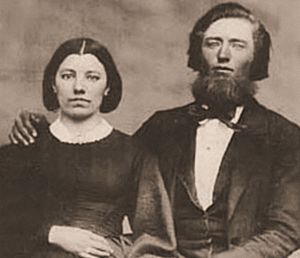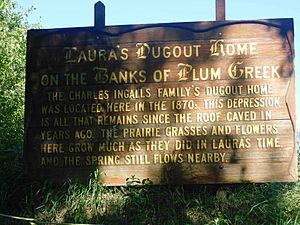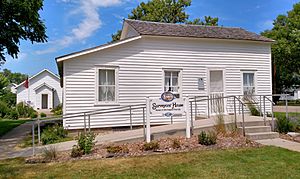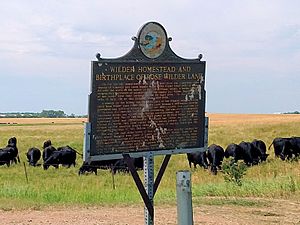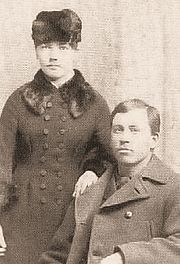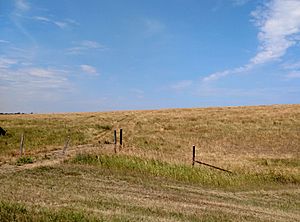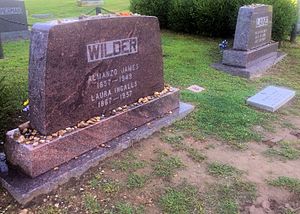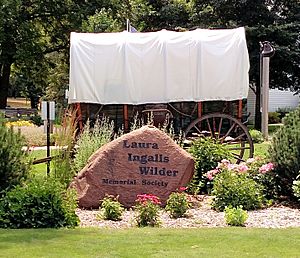Laura Ingalls Wilder facts for kids
Quick facts for kids
Laura Ingalls Wilder
|
|
|---|---|
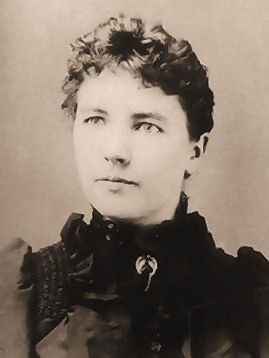
Laura Ingalls Wilder, circa 1885
|
|
| Born | Laura Elizabeth Ingalls February 7, 1867 Pepin County, Wisconsin, U.S. |
| Died | February 10, 1957 (aged 90) Mansfield, Missouri, U.S. |
| Resting place | Mansfield Cemetery, Mansfield, Missouri, U.S. |
| Occupation |
|
| Period | 1911–1957 (as a writer) |
| Genre | Diaries, essays, family saga (children's historical novels) |
| Subject | Midwestern and Western |
| Notable works | |
| Notable awards | Laura Ingalls Wilder Medal est. 1954 |
| Spouse | |
| Children | 2, including Rose Wilder Lane |
| Parents |
|
| Relatives |
|
| Signature | |
Laura Elizabeth Ingalls Wilder (February 7, 1867 – February 10, 1957) was an American writer. She is famous for her Little House on the Prairie series of children's books. These books, published between 1932 and 1943, tell the story of her childhood. They are based on her real-life experiences growing up in a settler and pioneer family.
The popular TV show Little House on the Prairie (1974–1983) was inspired by her books. In the show, Melissa Gilbert played Laura, and Michael Landon played her father, Charles Ingalls.
Contents
Laura's Early Life
Laura Elizabeth Ingalls was born on February 7, 1867. Her parents were Charles Phillip and Caroline Lake (née Quiner) Ingalls. At the time, her family lived in the Big Woods area of Wisconsin, about seven miles north of Pepin, Wisconsin. This home in Pepin became the setting for her first book, Little House in the Big Woods (1932).
Laura was the second of five children. Her older sister was Mary Amelia. Later, three more children were born: Caroline Celestia (Carrie), Charles Frederick (who died as a baby), and Grace Pearl. Today, you can visit a replica of her log cabin at the Little House Wayside in Pepin.
Laura was also related to some famous people. She was a descendant of the Delano family, which was the family of U.S. President Franklin D. Roosevelt. One of her ancestors, Edmund Ingalls, came to America from England and settled in Massachusetts. She was also a distant cousin of U.S. President and Civil War General Ulysses S. Grant.
Moving West
When Laura was two years old, her family moved from Wisconsin in 1869. After a brief stop in Missouri, they settled in what was then called Indian country in Kansas. This was near where Independence, Kansas is today. Her younger sister, Carrie, was born there in August 1870.
Laura's father, Charles, thought the land would be open for white settlers. However, it turned out to be part of the Osage Indian reservation. This meant the Ingalls family had no legal right to live there. They had just started farming when they heard they might be forced to leave. So, they left in the spring of 1871. Laura later wrote in her book Little House on the Prairie that they left because of these rumors. She also mentioned that her parents needed to get their Wisconsin land back because the buyer hadn't paid for it.
The Ingalls family returned to Wisconsin and lived there for three years. These experiences became the basis for her novels Little House in the Big Woods (1932) and the beginning of Little House on the Prairie (1935).
Around 1874, when Laura was about seven, her family moved again. This time they went to an area near Walnut Grove, Minnesota. They lived in a dugout home built into the side of a hill, on the banks of Plum Creek. This move is described in her book On the Banks of Plum Creek (1939).
After a difficult winter in the dugout, they built a new house on the same land. But two summers of ruined crops forced them to move to Iowa. On their way, Laura's brother, Charles Frederick ("Freddie"), was born in Minnesota in November 1875. He died nine months later. In Burr Oak, Iowa, the family helped run a hotel. Their youngest child, Grace, was born there in May 1877.
The family then moved back to Walnut Grove. Charles Ingalls worked as the town butcher and justice of the peace. In the spring of 1879, he took a railroad job in eastern Dakota Territory. The family joined him that fall. Laura's book By the Shores of Silver Lake (1939) tells about their time in Dakota Territory. She left out the time they spent in Burr Oak, Iowa, in her books.
Life in De Smet
Laura's father officially claimed land there in the winter of 1879–1880. De Smet, South Dakota became the permanent home for her parents and her blind sister Mary. They spent the mild winter of 1879–1880 in the surveyor's house. They watched the town of De Smet grow from the prairie in 1880. The next winter, 1880–1881, was one of the harshest ever in the Dakotas. Laura later wrote about it in her novel, The Long Winter (1940).
Once settled in De Smet, Laura went to school, worked part-time, and made friends. One of her friends was a homesteader named Almanzo Wilder. This period of her life is described in the books Little Town on the Prairie (1941) and These Happy Golden Years (1943).
Becoming a Young Teacher
On December 10, 1882, just before her 16th birthday, Laura started her first teaching job. She taught for three terms in one-room schools. She would teach when she wasn't attending school herself in De Smet. Laura later said she didn't really enjoy teaching. However, she felt it was her duty to help her family financially. There were not many ways for women to earn money back then. Between 1883 and 1885, she taught, worked for a local dressmaker, and went to high school. She didn't graduate from high school because her first teaching job started before she finished her studies.
Marriage and Early Challenges
Laura's teaching and studies ended when she married Almanzo Wilder on August 25, 1885. Laura was 18, and Almanzo was 28. They were married in De Smet, South Dakota. They had nicknames for each other: she called him "Manly," and he called her "Bess" (from her middle name, Elizabeth). Almanzo had a successful farm, and the newly married couple started their life together in a new home north of De Smet.
On December 5, 1886, Laura gave birth to their daughter, Rose. In 1889, she had a son who sadly died at 12 days old before they could name him. He was buried in De Smet.
Their first few years of marriage were very hard. In 1888, Almanzo became partly paralyzed after getting very sick with diphtheria. He eventually got most of the use of his legs back but needed a cane for the rest of his life. This was just one of many problems they faced. Their newborn son died, their barn burned down, and their home was accidentally destroyed by a fire started by young Rose. They also had several years of severe drought. These problems left them in debt, sick, and unable to make a living from their farm. Laura wrote about these difficult times in her book The First Four Years (published in 1971).
Around 1890, they left De Smet. They spent about a year resting at Almanzo's parents' farm in Spring Valley, Minnesota. Then they moved briefly to Westville, Florida, hoping the climate would help Almanzo's health. But they found the humid weather very different from the dry plains they were used to. They also felt out of place. So, they returned to De Smet in 1892 and bought a small home.
Moving to Mansfield, Missouri
In 1894, the Wilders moved to Mansfield, Missouri. They used their savings to buy an undeveloped property just outside of town. They called it Rocky Ridge Farm. They first lived in a simple log cabin. At first, they only earned money by selling firewood in town for 50 cents a wagon load.
It took time to become financially secure. Apple trees they planted didn't produce fruit for seven years. Around that time, Almanzo's parents visited and gave them the deed to the house they had been renting in Mansfield. This helped the Wilders a lot. They added more land to their farm, eventually owning nearly 200 acres. Around 1910, they sold the house in town and moved back to the farm. They used the money to finish building their farmhouse. What started as about 40 acres of wooded, stony land with a windowless cabin became a successful farm in 20 years. They raised poultry, had a dairy farm, and a large apple orchard.
The Wilders had learned from their past struggles with only growing wheat in De Smet. They made sure to have different types of farming at Rocky Ridge Farm. Laura became active in local clubs and supported farm associations. She was known for her knowledge of poultry farming and rural life. This led to her being invited to speak to groups in the area.
Laura's Writing Career
In 1911, Laura was asked to write an article for the Missouri Ruralist newspaper. This led to her getting a permanent job as a columnist and editor for the paper. She worked there until the mid-1920s. She also took a paid job with the local Farm Loan Association, helping farmers get small loans.
Laura's column in the Ruralist was called "As a Farm Woman Thinks." Her readers in the Ozarks region enjoyed her regular articles. She wrote about home and family, her trip to San Francisco, California in 1915 to visit her married daughter, Rose Wilder Lane, and even world events like World War I. She also wrote about her daughter Rose's travels and her own thoughts on the new opportunities for women at that time. The Wilders were not rich until the "Little House" books became popular. However, their farm and Laura's income from writing and the Farm Loan Association gave them a stable life.
By 1924, Laura had been writing for farm papers for over a decade. Professor John E. Miller noted that she had become a skilled writer. She could write thoughtful, easy-to-read articles for a general audience.
Around this time, her daughter, Rose, strongly encouraged Laura to improve her writing. Rose was already a successful writer herself. The Wilders had come to rely on money from their daughter. They both decided that Laura becoming a successful writer would help their retirement income. Rose helped Laura publish two articles about their farmhouse in Country Gentleman magazine.
In 1928, Rose had a stone cottage built for her parents next to their farmhouse. Rose then moved into the farmhouse herself.
The Stock Market Crash of 1929 caused the Wilders to lose most of their savings. Rose's investments were also badly hit. They still owned their 200-acre farm.
In 1930, Laura asked Rose for her opinion on a story she had written about her childhood. Laura was in her early 60s. The Great Depression and the deaths of her mother (1924) and older sister (1928) seemed to make her want to save her memories. She called her life story Pioneer Girl. She also hoped her writing would bring in some extra money.
The first book's original title was When Grandma Was a Little Girl. Rose's publisher suggested she make the story much longer. With Rose's help in editing and her connections in publishing, Harper & Brothers published Laura's book in 1932 as Little House in the Big Woods. After it became successful, she kept writing. Laura and Rose worked closely together, even though their relationship was sometimes difficult. This collaboration continued in person until 1935, when Rose left Rocky Ridge Farm for good. After that, they worked together through letters.
Rose also used her family's stories for her own successful novels. Let the Hurricane Roar (1932) and Free Land (1938) were written around the same time as the "Little House" series. They retold Ingalls and Wilder family tales for adult readers.
The Little House Books
- Little House in the Big Woods (1932)
- Farmer Boy (1933)
- Little House on the Prairie (1935)
- On the Banks of Plum Creek (1937)
- By the Shores of Silver Lake (1939)
- The Long Winter (1940)
- Little Town on the Prairie (1941)
- These Happy Golden Years (1943)
- The First Four Years (1971, published after her death)
Who Wrote Them?
Some people have wondered if Laura's daughter, Rose, was the real writer of the books. However, there is a lot of evidence that shows they worked together. Letters between them, Rose's diaries, and Laura's handwritten stories with edits all show that they collaborated.
Professor John E. Miller studied these records. He found that Rose helped more with some books than others. Little House in the Big Woods (1932) and These Happy Golden Years (1943) had the least editing from Rose. Miller noted that Laura had a talent for storytelling from the start. Other books had more help from Rose. The First Four Years (1971) seems to be entirely Laura's work.
Miller concluded that Laura's lasting literary work is more important than Rose's. He said, "Lane possessed style; Wilder had substance."
It's important to know that the Little House series has received some criticism. Literary scholar Rachelle Kuehl points out that some people have found Laura Ingalls Wilder's portrayal of Native Americans to be unfair or problematic. These books reflect the views of the time they were written, which are different from today's views.
Why They Are Still Popular
The original Little House books were written for elementary school-aged children. They became a lasting, eight-volume story of pioneer life in the late 1800s. They are based on the Ingalls family's experiences on the American frontier. The books start with a style that appeals to younger children and become longer and more complex as the series goes on. The First Four Years, about the early days of Laura and Almanzo's marriage, was found after Rose's death in 1968 and published in 1971. It is now considered the ninth book.
Since Little House in the Big Woods was published in 1932, the books have always been in print. They have been translated into 40 other languages. Laura's first royalty check from Harper in 1932 was for $500. By the mid-1930s, the money from the Little House books gave the Wilders a steady and growing income. This was the first time in their 50 years of marriage that they had such financial stability. The money also helped them recover from their losses in the stock market crash. Laura received many honors, fan letters, and other awards.
Pioneer Girl Autobiography
In 1929–1930, when she was in her early 60s, Laura started writing her autobiography. She called it Pioneer Girl. Publishers rejected it. At Rose's suggestion, Laura rewrote most of her stories for children. This led to the Little House series. In 2014, the South Dakota State Historical Society published an annotated (with notes and explanations) version of Laura's autobiography.
Laura's Political Views
Some people have called Laura Wilder one of America's first libertarians. She was a longtime member of the Democratic Party. However, she became unhappy with President Roosevelt's New Deal programs. She and her daughter, Rose Wilder Lane, felt that Americans were becoming too dependent on the government. Laura disliked government agents who questioned farmers about their crops. Her daughter was also a strong libertarian, believing in limited government.
Laura supported women's rights and education reform. She was also known for shaking the hand of an African American man in segregated Missouri, which was unusual at the time. In her book Little House on the Prairie, an African American doctor even saves the Ingalls family's lives.
Later Life and Death
After Rose left Rocky Ridge Farm, Laura and Almanzo moved back into the farmhouse they had built. They lived there alone from 1935 onward. They sold most of the surrounding land, but they still kept some farm animals and tended their gardens. Almost every day, fans would stop by, eager to meet the "Laura" from the Little House books.
The Wilders lived independently and without money worries until Almanzo died at the farm in 1949 at age 92. Laura remained on the farm. For the next eight years, she lived alone, cared for by neighbors and friends. She continued to write letters to her editors, fans, and friends.
In the fall of 1956, 89-year-old Laura became very ill. She had undiagnosed diabetes and heart problems. Rose came for Thanksgiving and had her hospitalized. Laura was able to return home the day after Christmas. However, her health got worse, and she died at home in her sleep on February 10, 1957. This was three days after her 90th birthday. She was buried next to Almanzo at Mansfield Cemetery in Mansfield. Rose was buried next to them when she died in 1968.
Laura's Estate
After Laura's death, Rocky Ridge Farm went to the farmer who had bought the property under a special agreement. However, local people formed a non-profit group to buy the house and land to turn it into a museum. Rose was at first unsure about making the house a museum. But she came to believe it would help keep the books popular. She donated the money to buy the house and make it a museum. She also agreed to give money each year for its upkeep and donated many of her parents' belongings.
Laura's will stated that Rose would own the Little House book rights during her lifetime. After Rose's death, all rights were supposed to go to the Mansfield library. However, after Rose died in 1968, her chosen heir, Roger MacBride, gained control of the book copyrights. He renewed the copyrights for Laura's books and Rose's own works in his name.
A disagreement arose after MacBride's death in 1995. The Laura Ingalls Wilder Branch of the Wright County Library in Mansfield, which Laura helped found, tried to get the rights to the series back. The court case was settled privately. MacBride's heirs kept the rights to Laura's books. The library received enough money from the settlement to start work on a new building.
The Little House books have become even more popular since Laura's death. They have led to a huge business of merchandise, new book series (some written by MacBride and his daughter), and the long-running television series.
Laura's Works
Because Laura died in 1957, her works are now in the public domain in many countries. This means they can be freely used by anyone.
The Original Little House Books
These eight books were published by Harper & Brothers.
- Little House in the Big Woods (1932)
- Farmer Boy (1933) – This book is about Almanzo Wilder's childhood in New York.
- Little House on the Prairie (1935)
- On the Banks of Plum Creek (1937)
- By the Shores of Silver Lake (1939)
- The Long Winter (1940)
- Little Town on the Prairie (1941)
- These Happy Golden Years (1943)
Other Writings
- On the Way Home (1962, published after her death) – This is a diary of the Wilders' move from De Smet, South Dakota, to Mansfield, Missouri. Rose Wilder Lane edited and added to it.
- The First Four Years (1971, published after her death) – This is often seen as the ninth Little House book.
- West from Home (1974, published after her death) – These are letters Laura wrote to Almanzo while visiting her daughter Rose in San Francisco in 1915.
- Little House in the Ozarks: The Rediscovered Writings (1991) – A collection of articles she wrote before 1932.
- The Road Back Home, part three (2006) – Laura's record of a 1931 trip with Almanzo to De Smet, South Dakota.
Laura's Legacy
Documentary Film
Little House on the Prairie: The Legacy of Laura Ingalls Wilder (February 2015) is a one-hour documentary film. It explores Laura's life as a writer, wife, and mother. It includes interviews with experts, old photos, paintings, and reenactments.
Historic Places and Museums
Many places related to Laura Ingalls Wilder's life have become museums or historic sites:
- Laura Ingalls Wilder House and Museum, Mansfield, Missouri
- Laura Ingalls Wilder Museum, Pepin, Wisconsin
- Laura Ingalls Wilder Museum, Walnut Grove, Minnesota
- Laura Ingalls Wilder Memorial Society museum and historic homes, De Smet, South Dakota; a yearly play is performed here.
- Laura Ingalls Wilder Park and Museum, Burr Oak, Iowa
- Little House on the Prairie Museum, Independence, Kansas
- Wilder Homestead, Malone, NY
- De Smet Cemetery in Kingsbury County, South Dakota, where many of the Ingalls family members are buried.
Portrayals in Movies and Shows
Many movies and plays have been made from Laura's Little House on the Prairie books. Here are some actresses who have played Laura:
- Melissa Gilbert in the TV series Little House on the Prairie and its movie sequels (1974–1984)
- Kazuko Sugiyama (voice) in the Japanese anime series Laura, The Prairie Girl (1975–1976)
- Meredith Monroe and Tess Harper (as an older Laura) in the TV films Beyond the Prairie: The True Story of Laura Ingalls Wilder (2000 and 2002)
- Kyle Chavarria in the TV miniseries Little House on the Prairie (2005)
- Kara Lindsay in the Little House on the Prairie musical (2008–2010)
Wilder Medal
Laura Wilder was a runner-up five times for the annual Newbery Medal. This is a top book award for children's literature from the American Library Association (ALA). In 1954, the ALA created a new award for children's writers and illustrators, named after Laura Wilder. She was the first person to receive it. The Laura Ingalls Wilder Medal honored a living author or illustrator whose books made a "substantial and lasting contribution to literature for children."
In 2018, the award was renamed the Children's Literature Legacy Award. This change happened because some of the language in Laura Wilder's books was seen as biased against Native Americans and African Americans.
Other Honors
- A Google Doodle celebrated her 148th birthday in 2015.
- A bronze statue of Laura Wilder is on display in the Hall of Famous Missourians at the Missouri State Capitol. She was added in 1993.
- She was honored on the Missouri Walk of Fame in 2006.
- A crater on the planet Venus is named "Wilder crater" after her.
See also
 In Spanish: Laura Ingalls Wilder para niños
In Spanish: Laura Ingalls Wilder para niños


